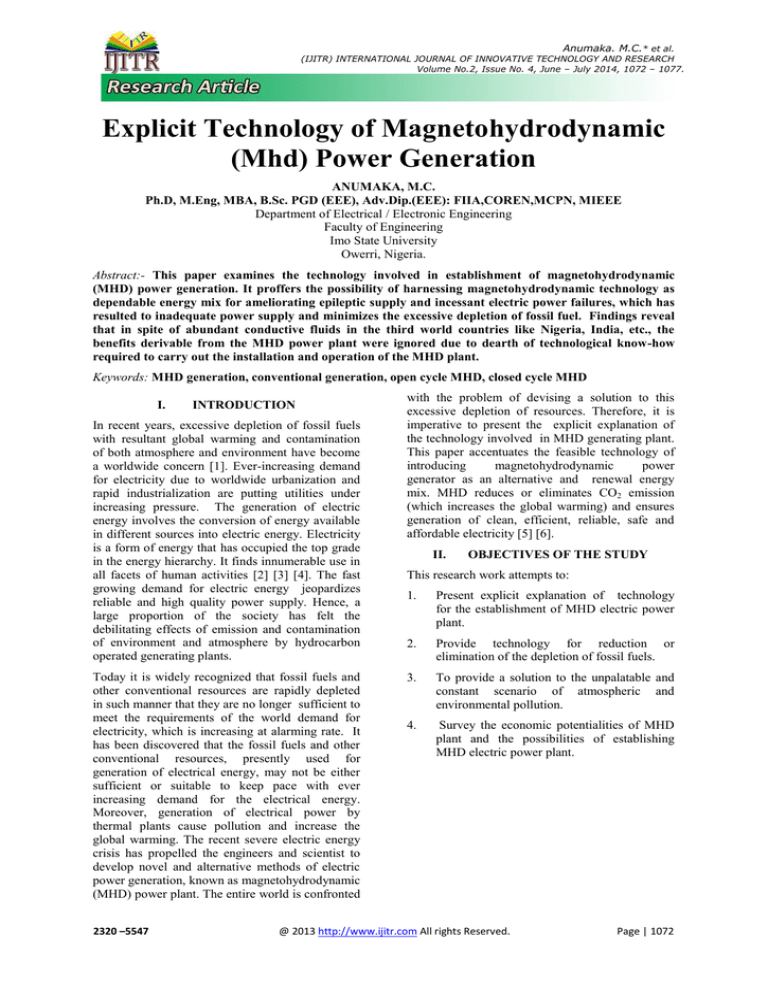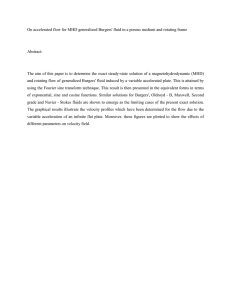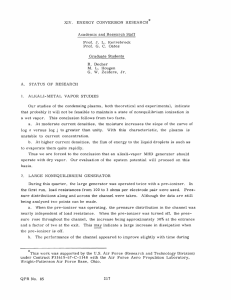
Anumaka. M.C.* et al.
(IJITR) INTERNATIONAL JOURNAL OF INNOVATIVE TECHNOLOGY AND RESEARCH
Volume No.2, Issue No. 4, June – July 2014, 1072 – 1077.
Explicit Technology of Magnetohydrodynamic
(Mhd) Power Generation
ANUMAKA, M.C.
Ph.D, M.Eng, MBA, B.Sc. PGD (EEE), Adv.Dip.(EEE): FIIA,COREN,MCPN, MIEEE
Department of Electrical / Electronic Engineering
Faculty of Engineering
Imo State University
Owerri, Nigeria.
Abstract:- This paper examines the technology involved in establishment of magnetohydrodynamic
(MHD) power generation. It proffers the possibility of harnessing magnetohydrodynamic technology as
dependable energy mix for ameliorating epileptic supply and incessant electric power failures, which has
resulted to inadequate power supply and minimizes the excessive depletion of fossil fuel. Findings reveal
that in spite of abundant conductive fluids in the third world countries like Nigeria, India, etc., the
benefits derivable from the MHD power plant were ignored due to dearth of technological know-how
required to carry out the installation and operation of the MHD plant.
Keywords: MHD generation, conventional generation, open cycle MHD, closed cycle MHD
I.
INTRODUCTION
In recent years, excessive depletion of fossil fuels
with resultant global warming and contamination
of both atmosphere and environment have become
a worldwide concern [1]. Ever-increasing demand
for electricity due to worldwide urbanization and
rapid industrialization are putting utilities under
increasing pressure. The generation of electric
energy involves the conversion of energy available
in different sources into electric energy. Electricity
is a form of energy that has occupied the top grade
in the energy hierarchy. It finds innumerable use in
all facets of human activities [2] [3] [4]. The fast
growing demand for electric energy jeopardizes
reliable and high quality power supply. Hence, a
large proportion of the society has felt the
debilitating effects of emission and contamination
of environment and atmosphere by hydrocarbon
operated generating plants.
Today it is widely recognized that fossil fuels and
other conventional resources are rapidly depleted
in such manner that they are no longer sufficient to
meet the requirements of the world demand for
electricity, which is increasing at alarming rate. It
has been discovered that the fossil fuels and other
conventional resources, presently used for
generation of electrical energy, may not be either
sufficient or suitable to keep pace with ever
increasing demand for the electrical energy.
Moreover, generation of electrical power by
thermal plants cause pollution and increase the
global warming. The recent severe electric energy
crisis has propelled the engineers and scientist to
develop novel and alternative methods of electric
power generation, known as magnetohydrodynamic
(MHD) power plant. The entire world is confronted
2320 –5547
with the problem of devising a solution to this
excessive depletion of resources. Therefore, it is
imperative to present the explicit explanation of
the technology involved in MHD generating plant.
This paper accentuates the feasible technology of
introducing
magnetohydrodynamic
power
generator as an alternative and renewal energy
mix. MHD reduces or eliminates CO2 emission
(which increases the global warming) and ensures
generation of clean, efficient, reliable, safe and
affordable electricity [5] [6].
II.
OBJECTIVES OF THE STUDY
This research work attempts to:
1.
Present explicit explanation of technology
for the establishment of MHD electric power
plant.
2.
Provide technology for reduction or
elimination of the depletion of fossil fuels.
3.
To provide a solution to the unpalatable and
constant scenario of atmospheric and
environmental pollution.
4.
Survey the economic potentialities of MHD
plant and the possibilities of establishing
MHD electric power plant.
@ 2013 http://www.ijitr.com All rights Reserved.
Page | 1072
Anumaka. M.C.* et al.
(IJITR) INTERNATIONAL JOURNAL OF INNOVATIVE TECHNOLOGY AND RESEARCH
Volume No.2, Issue No. 4, June – July 2014, 1072 – 1077.
III.
MAGNETOHYDRDYNAMIC POWER
GENERATOR
Figure 1.0 Magnetohydrodydnamic power
generator.
A magnetohydrodynamic (MHD) generator (figure
1.0.) is an electrical device that transforms thermal
energy and kinetic energy of working fluid into
direct electrical energy [10][11]. The word “
magnetohydrodynamic” comprised of the words:
magneto- meaning magnetic field, hydro-meaning
water (or liquid or fluid) and dynamic, which
implies movement by force. MHD generates
electricity directly from a fast moving stream of
ionized gases without the need for any moving
mechanical parts like turbines, rotary armature. In
conventional generators, the conductors consist of
copper strips, but in MHD generators the solid
conductors are replaced by ionized gases, which
are passed at high velocity through intense
magnetic field. The direct current electricity
generated can be extracted by placing electrodes at
suitable positions in the stream as schematically
illustrated in figure 2.0. Sequel to the superiority of
a.c. power over d.c. power, inverters are used to
convert d.c. into a.c. for bulk supply.
Figure.2.0 Schematic diagram of MHD generator
uses the motion of mechanical devices to
accomplish this. The functional difference between
an MHD generator and an MHD dynamo is the
path the charged particles follow.
Presently, nearly all electrical power generators
utilize a solid conductor, which is caused to rotate
between the poles of magnet by a prime mover. In
the case of hydroelectric generators, the energy
required to maintain the rotation is supplied by the
gravitational motion of river water. Turbogenerators, on t he other hand, generally, operate
using a high-speed flow of steam or other gas. The
heat source required to produce the high-speed gas
flow can be supplied by the combustion of a fossil
fuel in combustion chamber or by a nuclear reactor.
IV. HISTORY OF
MAGNATOHYDRODYNAMIC
GENERATOR
This device was the brain child of the English
physicist, Michael Faraday (1791-1867). He
originated the idea in 1832. He tested this concept
by immersing electrodes into the Thames River at
either end of the bridge and connected the
electrodes at mid-span through a galvanometer.
Faraday reasoned that the electrically conducting
river water moving through the earth’s magnetic
field can produce a transverse emf, and he
observed small irregular deflections of the
galvanometer. However, the actual utilization of
this concept remained unthinkable until 1936, when
the Westinghouse Research Laboratory (USA)
attempted to develop a Hall type MHD generator
under the guidance of Karlovit, a Hungarian
engineer. The experiments did not produce the
expected power levels because of the low electrical
conductivity of the gas and the lack of existing
knowledge of plasma properties at that time. Later
Westinghouse conducted another experiment in
1961 headed by the American engineer, Richard
Rosa, utilizing a liquid fossil fuel “seeded” with a
potassium compound to produce 10kW MHD
generator. Today, MHD plants that can yield power
levels in excess of 30kW are available and widely
used in advanced countries [9].
MHD generators are fluid dynamos; they are
different from conventional generators (mechanical
dynamos) because they can operate at high
temperatures without moving components. Again,
the exhaust gas is a flame, which can be use to
heat, the boilers of steam power plants or recycled
for operating MHD power plant [8] [9]. The basic
concept underlying the mechanical and fluid
dynamos is the same. The fluid dynamo uses the
motion of fluid or plasma to generate the electrical
energy, while the mechanical dynamo, in contrast,
2320 –5547
@ 2013 http://www.ijitr.com All rights Reserved.
Page | 1073
Anumaka. M.C.* et al.
(IJITR) INTERNATIONAL JOURNAL OF INNOVATIVE TECHNOLOGY AND RESEARCH
Volume No.2, Issue No. 4, June – July 2014, 1072 – 1077.
V.
OPERATION PRINCIPLE OF MHD
POWER GENERATIOR
Figure 3. (a) Conventional generation of
electricity (b) Magnatohydrodynamic generation
of electricity,
Like the conventional electrical generators (figure
3a), the principle of operation of MHD generators
(figure 3b)
is based on Faraday's Law of
Electromotive induction, which states that energy is
generated due to the movement of conductor inside
the magnetic field. As the conducting gases move
through the magnetic field, electromotive
force(emf)
is generated in accordance with
Faraday’s law of induction as shown in figure 4,
and the plasma experiences retarding force (or
Lorentz Force) as well as Faraday’s current
(induced current), which flow into the electrodes.
The Faraday’s current that flows into the load react
with the applied magnetic field, creating a Hall
Effect current perpendicular to the Faraday’s
current and resulting lost of energy. In an
electrically conducting fluid, moving at velocity V,
in a magnetic field B, an electromotive force E =
(V x B) is induced. When a conductor moves
through the magnetic field it creates an electrical
field that acts in a direction perpendicular to both
the gas flow and the magnetic field, in accordance
with Fleming’s Right Hand Rule. Figure 4
illustrates the principle of MHD power generation
[11] [12]
Figure 4. Principle of MHD power generation
2320 –5547
The walls of the channel parallel to the magnetic
field serve as electrodes and enable the generator to
produce direct electric current to an external
circuit. Inverter is used to convert d.c. power
produced by the MHD into a.c. power. For
adequate operation of the MHD plant, the
conducting gas is produced at high temperature and
pressure. The speed of the plasma is then
accelerated by a nozzle and injected into the
magnetic field. The expansion nozzle reduces the
gas pressure and consequently increases the speed
of the plasma (as noted in the Bernoulli’s Law)
through the generator duct, thereby increasing the
generator output. However, Gay-Lussac’s Law is
also applied at the same time the pressure drops,
causing the temperature to reduce, thereby
increasing the plasma resistance. For MHD
generators to operate competitively with good
performance and reasonable physical dimensions,
the electrical conductivity of the plasma must be in
a temperature range between 1,5000C to 2,5000C.
High value of fluid conductivity ranging from 10 to
50 Siemens per meter can be achieved through
injection (seeding) of readily ionizable alkali
material like potassium carbonate (sodium), cesium
and rubidium, typically about 1 percent by mass
into the hot gas. Even though the amount of seed
material is small, economic operation requires that
a system be provided to recover as much of it as
possible. MHD generator offers the potential of an
ultimate efficiency in the range of 60 to 65 percent.
This is much better than the 35 to 40 percent
efficiency that can be achieved in a modern
conventional plant. In addition, MHD generators
produce fewer pollutants than conventional plants.
The electrical current of density J, is produced by
the electromotive force , the magnitude of the
current density for the conductive gas is given by
the generalized Ohm’s law as:
J = σ. (E + V x B).
(1)
When an electrical conductor is moved so as to cut
lines of magnetic induction, the charged particles in
the conductor experience a force in a direction
mutually perpendicular to the magnetic field (B),
and to the velocity of the conductor (V). The
negative charges tend to move in one direction, and
the positive charges in the opposite direction. This
induced electric field, or motional emf, provides
the basis for converting mechanical energy into
electrical energy
The Lorentz Force Law describes the effects of a
charged particle moving in a constant magnetic
field. The Lorentz law is given by the vector
equation.
F = Q · (v × B),
@ 2013 http://www.ijitr.com All rights Reserved.
(2)
Page | 1074
Anumaka. M.C.* et al.
(IJITR) INTERNATIONAL JOURNAL OF INNOVATIVE TECHNOLOGY AND RESEARCH
Volume No.2, Issue No. 4, June – July 2014, 1072 – 1077.
Where:
F = Force acting on the particles (vector).
For the generator being discussed,
ne
Q =Charge on the particle (scalar).
The Faraday generator therefore tends to higher
efficiency near open circuit operation.
V = Velocity of the particle (vector).
B = Magnetic field (vector).
X = the cross product.
The vector F, is perpendicular to both V and B in
accordance with the Fleming’s Right hand rule.
For general load conditions, it is conventional to
introduce the loading parameter
K= Ey/uB
VI.
≤ 1, and Jy = - σuB (1 – k).
Negative sign shows the conventional current flows
in the negative y-direction. Since the electrons flow
in the opposite direction, the bottom electrode must
serve as an electron emitter, or cathode, and the
upper electrode is an anode. The electrical power
delivered to the load per unit volume of a MHD
generator gas is:
P = - J. E.
(4)
The power supplied in MHD generators shown in
Fig. 3b, and 4 is [2]:
P = σv2 B2 K (1 – K) W/m3
Using the preceding characteristic values for V and
B, this requirement means that the electrical
conductivity must be such that
(8)
(3)
Where:
0≤K
= K
(5)
P = generated power (MW)
σ = specific electrical conductivity (siemn/m3)
CONSTRUCTION STRUCTURES OF
MHD POWER PLANT
The construction of a MHD generator resembles a
rocket engines, consists of intense magnetic fields
placed side by side and electrodes lying parallel to
each other. The duct is made of non- conducting
materials and
heat- resistance materials like
zirconium dioxide or yttrium oxide that can
withstand high temperature ranging from 10000C to
30000C. The electrodes also must of course be
conducting as well as heat resistant. The entire
MHD generating plant consists of vital elements
such as fuel processor, combustion chamber,
expansion nuzzle, heat exchanger, seed recovery or
pre-heater, purifier, compressor, inverter, and stalk
(figure 6).
VII.
TYPES OF MHD GENERATORS AND
GENERATING PLANTS
The MHD generators can be classified based on:
B = magnetic field (Tesla)
(i)
V = velocity of gas (m/s)
K = ratio of external load voltage to open-circuit
voltage
The configuration of the electrodes
which include.
(a) Faraday MHD generator,
(b) Hall MHD generator,
This power density has a maximum value
(c) Series MHD generator.
(ii)
(6)
For K = 1/2. The rare at which directed energy is
extracted from the gas by the electromagnetic field
per unit volume is - u. (J x B). We therefore define
the electrical efficiency of a MHD generator as:
the nature of processing and control
of working fluid , which can be
arranged as:
(a) Open cycle MHD generating
plant.
Hybrid open cycle MHD
generating plant.
(b) Closed cycle MHD generating
plants
(7)
2320 –5547
@ 2013 http://www.ijitr.com All rights Reserved.
Page | 1075
Anumaka. M.C.* et al.
(IJITR) INTERNATIONAL JOURNAL OF INNOVATIVE TECHNOLOGY AND RESEARCH
Volume No.2, Issue No. 4, June – July 2014, 1072 – 1077.
Figure 5. Types of MHD generator: (a) Faraday, (b) Hall, (c) Series type.
VIII. OPEN CYCLE MHD GENERATING
PLANT
Open cycle MHD generating plant is illustrated in
figure 6. In open-cycle system of MHD power
generation, the working fluid after the generation
of electrical energy is discharged into the
atmosphere [13].
IX.
CONCLUSION
Magnetohydrodynamic generation has become a
vital alternative means of generating electricity in
the
modern
civilization.
It
eliminates
environmental pollution caused by conventional
power generating plants, and reduces excessive
2320 –5547
The fossil fuel is admitted into the combustion
chamber that operates at temperature ranging from
2,0000C to 2, 8000 C. The hot gases are mixed with
ionized alkali metals such as cesium and potassium
to increase the
depletion of fossil fuel and global warming.
Knowledge of MHD technology will encourage
establishment of MHD plants, even in the under
developed countries.
@ 2013 http://www.ijitr.com All rights Reserved.
Page | 1076
Anumaka. M.C.* et al.
(IJITR) INTERNATIONAL JOURNAL OF INNOVATIVE TECHNOLOGY AND RESEARCH
Volume No.2, Issue No. 4, June – July 2014, 1072 – 1077.
X.
REFERENCES
[1]
Biskamp, D. (2003) Magnetohydrodynamic
Turbulence, Cambridge
University Press
(ISBB: 0521810116)
[2]
Gupta, B.R.(2007) Power System Analysis
and Design S.Chand, New Delhi ISBN 81219-2238-0.
[3]
Metha V.K. and Metha R. (2004) Principles
of Power System” S. Chand & Compliancy
Ltd. New Delhi ISBN 81-219-2496-0.
[4]
Anumaka M.C.and Chidolue G.C. (2013).
Evaluation of Technical Power Losses in the
Nigerian 330kV Transmission Network.
International Transactions on Electrical,
Electronics and Communication Engineering
(ITEECE) ) No. 3.No.1 2013.
[5]
Nelson, R.P. & Papaloizou, J.C. B. (2004).
The interaction of giant planets with a disc
with MHD turbulence- IV. Migration rates
of embedded protoplanets MNRAS 350, p.
849
[6]
Proga, D., MacFadyen, A.I., Armitage, P.J.,
Begelman, M.C. (2003), Axisymmetric
Magnetohydrodynamic Simulations of the
Collapsar Model for Gamma-Ray Bursts,
ApJ. 599, L5
[7]
vishal. d. Dhareppagol and Anaud Sauray
(2013) The Future Power Generation with
MHD Generators-Magneto Hydro Dynamic
Generation.IJAEEE. Volume 2. Isssue 6,
2013.
[8]
Rai G.D. (2010). An Introduction to Power
Plant Technology. Khanna Publishers, New
Delhi
[9]
Nordlund, A., Galsgaard, K. & Stein, R.F.
(1994)
Magnetoconvection
and
magnetoturbulence in NATO Advanced
Science Institutes (ASI), (Dordirecht,
Lluwer), P. 471.
[10]
Tillack M.S. and Morley N.B. (1998)
MAGNATOHYDRODYNAMICS. McGraw
Hill, 14th Edition.
[11]
Rosa, R. J. (1968) Magnetohydrodynamic
Energy Conversion, McGraw-Hill. New
York.
[12]
Patrick, M. and Shumyatsky, B. Ya., Eds.
(1979) Open-Cycle Magnetohydrodynamic
Electrical Power Generation. A Joint
Publication U.S. A./U.S .S ,R., Argonne
National Laboratory, Argonne, IL., USA.
2320 –5547
[13]
Shioda, S. "Results of Feasibility Studies on
Closed-Cycle MHD Power Plants", Proc.
Plasma Tech. Conf., 1991, Sydney,
Australia, pp. 189–200.
@ 2013 http://www.ijitr.com All rights Reserved.
Page | 1077





